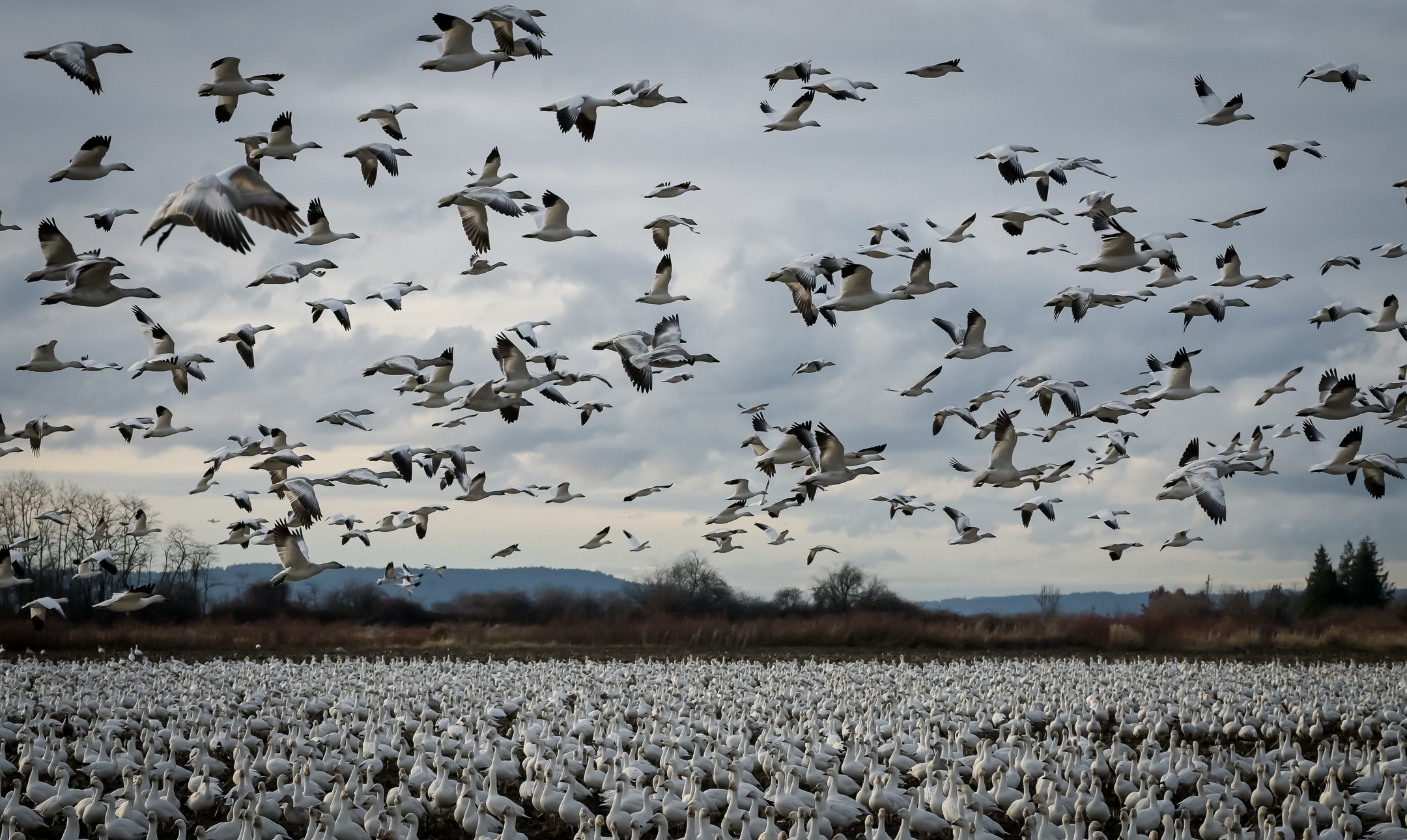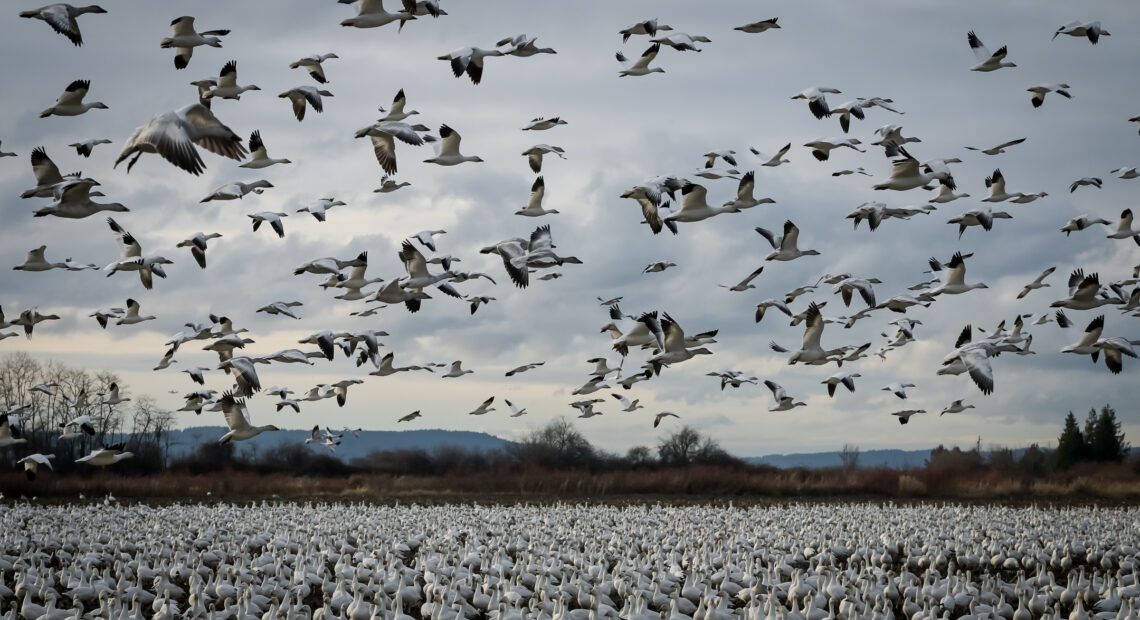
Snow geese winter population in Skagit on the rise, posing problems to farmers
Listen
(Runtime 4:15)
Read
In late autumn on the cusp of cool winter days, snow comes early to Washington when thousands of aloft avians, snow geese, land here in a flurry of white feathers.
“We call it a snow storm, they just will move as one,” said birder Julie Hagen. “It’s just this chaotic whirlwind of birds, they move like a cloud and then they just lift up in the air.”
In late October, as the snow geese began landing in the Skagit Valley, Hagen went out to enjoy the sight that many Western Washington birders look forward to each year. Lucky and patient observers might get to see the spectacle Hagen calls a snow storm, when the birds take off in a group. The individual birds become indistinguishable from each other within all those white feathers.
“The sight and the sound they make, the sound is incredible,” Hagen said. “It’s just a real, multi-sensory experience, I think, and I think that’s what a lot of birders love to experience about the snow geese.”
Beloved for their look and sound, the distinct white birds, with black tips on their wings, are Lesser Snow Geese who overwinter here, coming from their summer home of Wrangel Island, a World Heritage site in Russia.
The thing is, there’s a lot more of these birds landing and spending their winters here, lately. That’s bringing about questions of how species interact with, impact and are impacted by the build environment.
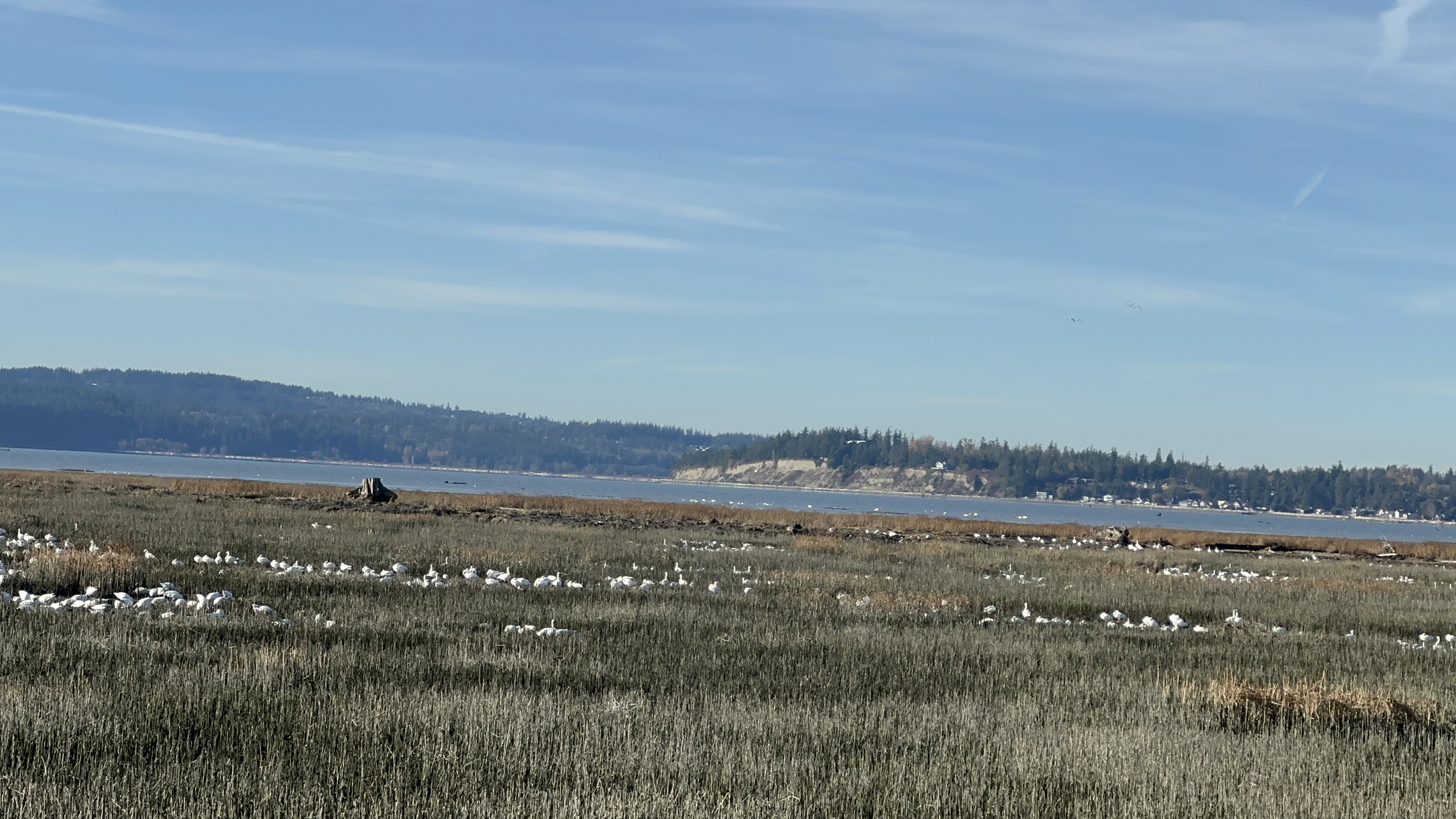
Port Susan Bay Preserve is settled next to agriculture land, making it a prime spot for snow geese to feed. See the white spots dotting the grasses? Hundreds of geese. (Credit: Lauren Gallup / NWPB)
Finding a feast
In the northwest corner of Washington in the Skagit Valley, Port Susan Bay Preserve is a great place to catch sight of the geese; it’s within a National Audubon Important Bird Area and within a part of the Western Hemisphere Shorebird Reserve Network.
The estuary is settled next to agriculture lands, a paradise for the birds who are seeking food resources, said Amber Parmenter, Puget Sound stewardship manager for the Nature Conservancy, who manages this site. Growing abundantly is Bulrush and the geese like to yank out the plant’s roots from the marshy landscape for a meal. But it’s not just these roots that the geese like to feast on. Foods found on our dinner table — potatoes, winter wheat and corn — are crops these birds enjoy too.
“Agriculture is why we have, in large part, the waterfowl populations in North Puget Sound that we have,” said Rob Wingard, private lands biologist for the Washington State Department of Fish and Wildlife. “We have, over winter, large numbers of ducks and geese because of the mix of estuary habitat and prime agricultural ground.”
The numbers of snow geese here have been increasing — the population on Wrangel Island has gone from around 50,000 in the 1970s to over 300,000 now.
The Department of Fish and Wildlife does their regional population surveys of the geese later in the winter. For the March 2023 survey flight, the department counted 91,608 birds from southern British Columbia and down south to northern King County. Adding the season’s hunting count, the department estimated 102,390 snow geese overwintered in the area.
The department added that this is high, but trending down from the peak increase seen in recent years.
Why the overall increase? A combination of conservation efforts, including better hunting management and a recent string of strong hatching seasons in the Arctic have led to population increases — and snow geese have a long lifespan, more than 15 years.
“So they’re doing well, but maybe they’re doing too well,” Parmenter said.
The geese can damage estuary habitat, ripping out the Bulrush roots and preventing sediment from building up, which is crucial for shoring up the habitat. The geese can also threaten crops farmers rely on for their livelihood.
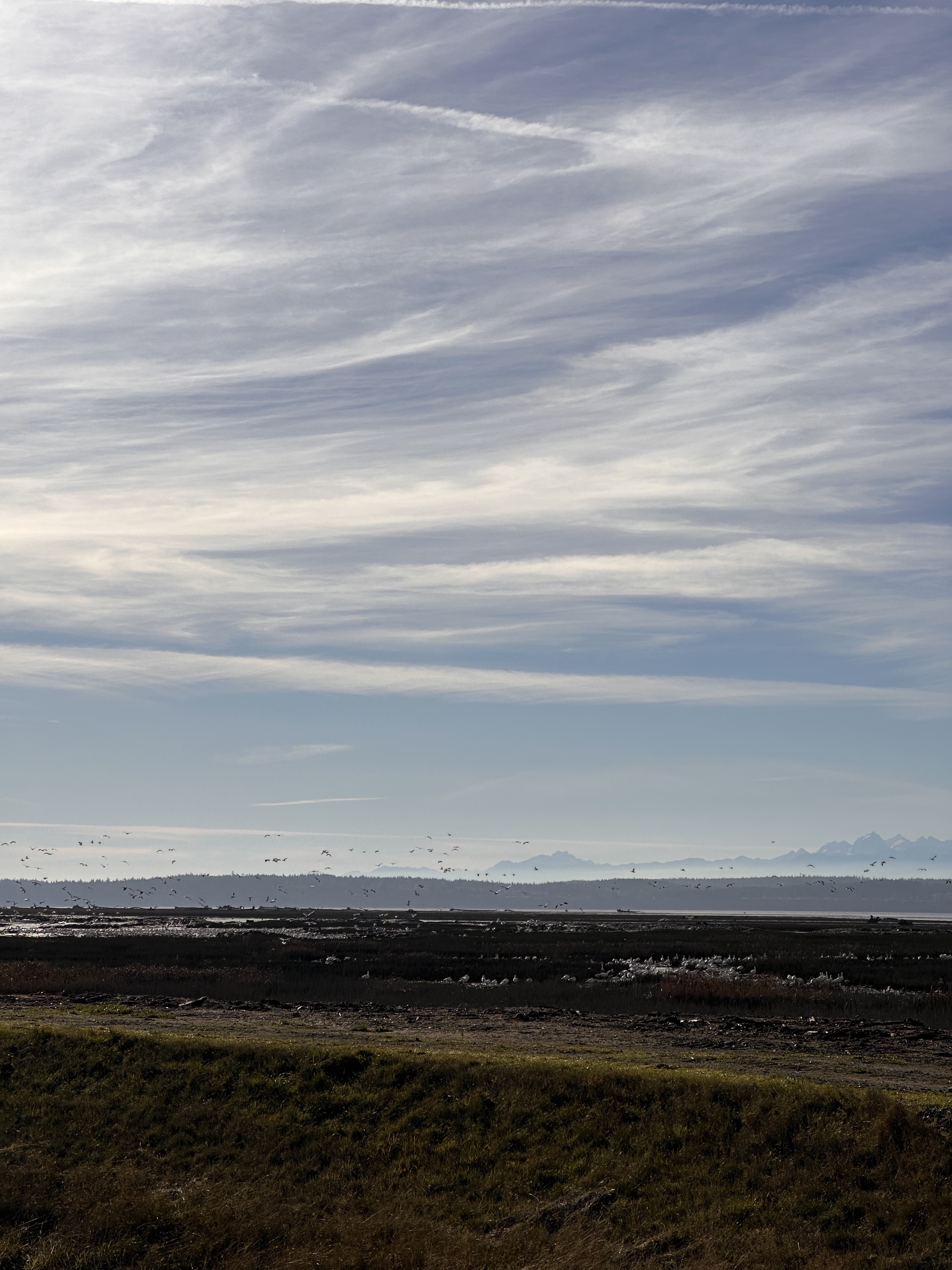
The estuary has plentiful foods to offer the geese in the form of Bulrush roots, but when geese yank the roots from the ground over and over, that compromises the shore. (Credit: Lauren Gallup / NWPB)
Grazing dilemmas
While many farmers don’t mind the geese grazing sometimes, Wingard said, the birds can be detrimental to a farm.
“When the geese come into the fields in large numbers, they can really mow down and graze down that field heavily,” Wingard said.
Jason Vander Kooy is a dairy farmer in Skagit County where he grows close to 1,000 acres of grassland for his cows to graze on. Unfortunately for him, the geese like to graze on the grass too. In recent years, the number of dairy farms in Skagit County has gone down while the number of geese has gone up, meaning more birds and less acres for them to graze on, Vander Kooy said.
That equation makes for a costly impact to farmers — somewhere between $50,000 and $100,000 worth of feed for Vander Kooy for a season. When he loses that homegrown grass feed for his cows, he has to supplement and buy hay from Eastern Washington.
Vander Kooy doesn’t even plant cover crops anymore; he said it’s just too much of a loss.
With the population increases, hunting regulations, overseen by the Department of Fish and Wildlife, are allowing people to bag more birds. In the eight years Wingard has worked for the department, the daily limit for hunters has gone from four geese to 10.
“That is a reflection of how successful the population has been over the last few years,” Wingard said.
Yet hunting has to be done responsibly. The department, which oversees hunting regulations for the state, works with other states to set the hunting season dates and regulations of how many animals hunters can take. Regulations for the waterfowl hunting season can be found here.
Parmenter will sometimes find geese that have been injured from hunters, but that are still living and are able to be saved.
“If the injuries aren’t terrible, I will take them to a wildlife rescue to try to give them the best chance,” Parmenter said.
Of course, there’s other options besides hunting, like setting up decoys that fool birds into thinking there’s predatory eagles in the fields — even something as simple as a plastic bag on a steak flapping in the wind kind of looks like an eagle, Wingard said.
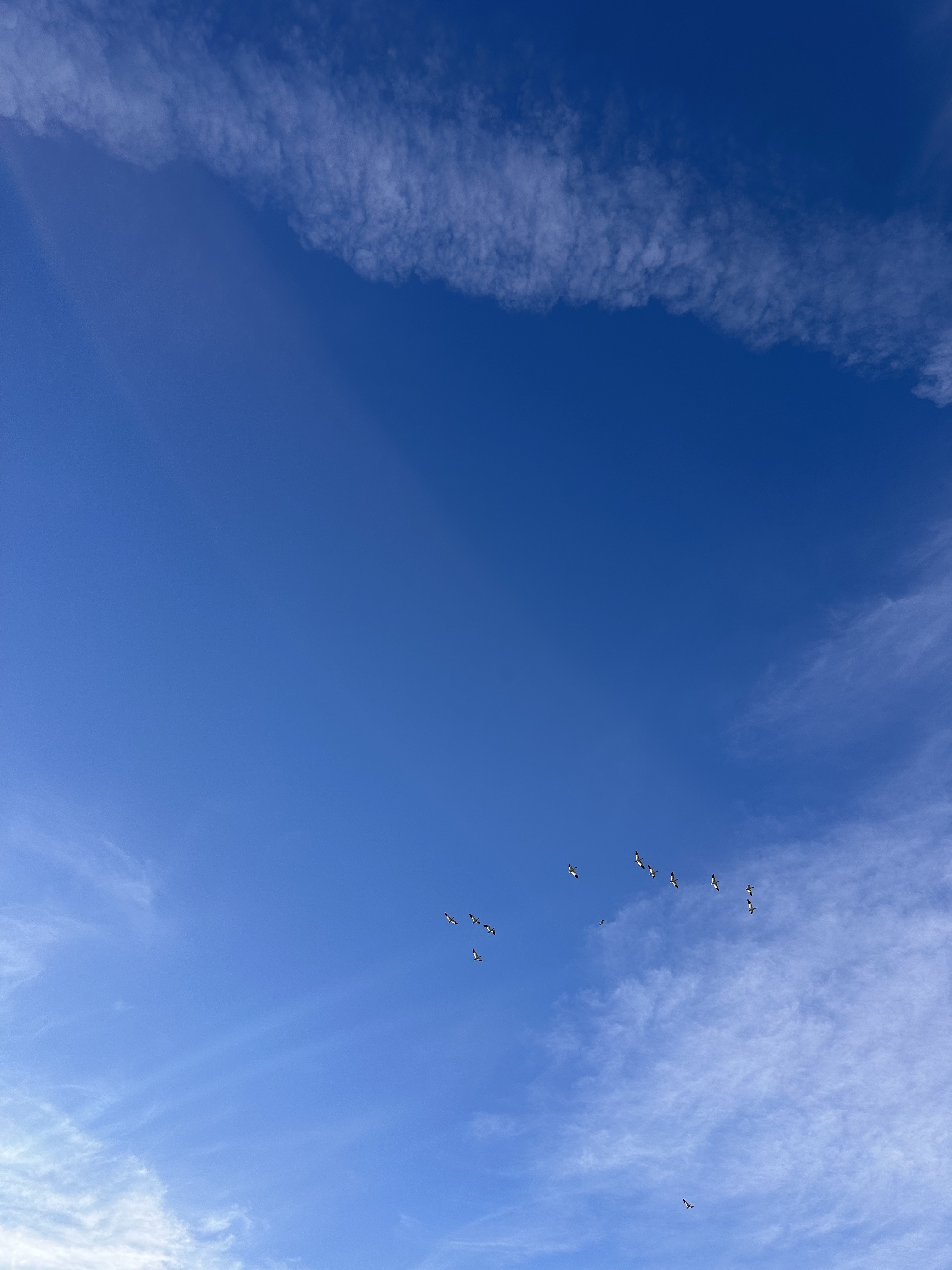
Snow geese fly over head in the Skagit Valley. (Credit: Lauren Gallup / NWPB)
It’s a real balance that requires a lot of monitoring to figure out how the geese are doing in the wild, and what impact they might have on the environment to know how to respond — and one that can change over time.
And while the snow geese population is in many ways a success story, there are many threats facing birds, particularly during the tenuous time of migration. Last year, avian flu killed a number of snow geese and it’s impacting cackling geese in Oregon in big numbers this season.

